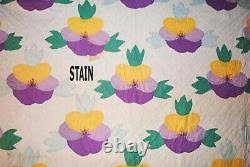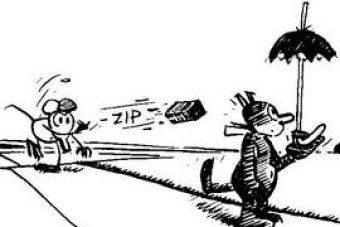"Everyone needs protective covers for the bed," a 1941 newspaper article relayed. "The protective covers needed for a bed are spring-covers, mattress covers and mattress pad, pillow protection and quilt protection." Of course these are basic necessities that we include in our bedrooms. Until you wonder...wait...quilt protection?
We now call them "chin guards" or "whisker guards" but old newspapers and booklets suggest that they were always referred to as "quilt protectors". So what is this thing?
A few weeks ago, I shared a photo of a 16 patch quilt from the turn of the century:
See that blue stripe of later fabric along the bottom of the quilt? The quilt pictured there is likely upside down. That blue fabric was likely a repair job that someone did because the edges of the quilt were likely fraying. Beth and I always mused that if the quilts had a guard on the edge, there wouldn't be so much damage. I don't have a quilt that shows what kind of wear a quilt can endure but here is a great photograph that illustrates common damage.
Enter the quilt protector. I found this photo online that demonstrates the use. A piece of fabric was folded over the top and adhered to the quilt:
That piece of plain muslin basted to the top of the quilt helped keep the quilt clean. As a 1928 article stated: "they (quilts) are bound to get soiled. A splendid way to protect against this is to sew a white strip across the top of the comfort. This is easily laundered and sewed on the quilt, and of course, may always be kept clean as well as keeping the quilt clean. It could be removed, washed and re-basted onto the quilt to protect the edge of the quilt."
Now folklore suggests that the most damage down to that edge of the quilt was due to a man's beard rubbing against it, hence the name "whisker or beard guard". But the truth is that most of the wear on quilts was due to being pulled up. Quilts were often heavy, especially older quilts with a lot of quilting and heavier batting. And yet...
😮😮😮😮
I never found an article that suggested the beard theory or even fraying. Cleanliness appears to be the number one reason it was recommended. Believe me, if you ever washed a quilt without a washing machine, you will know that it is a cumbersome task. Getting quilts dried on the line might have taken a day or two.
So when was this "boudoir accessory" first used? I don't know. There isn't much mention of the pieces before the 20th century. A 1910 ad mentions that they sell quilts and protectors as if the general public would understand the concept. Shortly afterwards, more and more articles discuss the value of the protector, ads sell protectors (finished or stamped for embroidery).
The protectors were often suggested for infant quilts. One 1925 article describes how to make a protector for an infant quilt and states that it will protect the quilt from being soiled--but also-- "protect baby from inhaling or having contact with any dust which ay have collected along the quilt edges." I am now wondering if the protectors were first used on crib quilts because the article ends with this question: "I do not see why we could not carry out this same idea with our big 'puffs,' on our full-size beds?"
Lightweight fabrics were often recommended for early twentieth century protectors. One 1913 article suggested that the protector should be made of cheese cloth. I'm not sure why but maybe because it was cheap and could be adhered and removed easily. Voile was another option sold. Some articles suggested lawn or handkerchief fabric. This article, suggested another lightweight fabric, dimmity:
Note that this article indicated protectors on all of the sides of the quilt.
By the 1930s, muslin was recommended more frequently:
"take two yards of twenty-inch muslin, scallop the raw edge, then bind the scallops (do not cut them too deep) and both ends with colored bias binding. The selvage edge does not need binding. Now embroider sprays of flowers in the center of each scallop..." (1934)
During the depression, demonstrations were featured at community groups like the 4-H and women's groups. Fabric suggestions included fabric scraps, scraps from worn clothing, unbleached muslins, old sheets, gingham or print materials--"just so it is washable."
A quilt protector from my collection. The fold is at the top and the bottom is edged with embroidery: Stamped linens and transfers were also sold for women to make the protectors.
Ad above from 1915
Ad below from 1925:
So what happened to the idea of the quilt protector?
What I can tell you that teaching demonstrations for the protectors continued through the 1950s. There were fewer discussions in the 1960s and predominately in midwest rural communities. One reason may be the idea of what was similar to a duvet was being marketed:
By the 1970s, the one reference I found was a description of a woman who taught how to make cheese, can food, and taught how to make quilt protectors--but the article was referring to her work in the 1930s.
One interesting article from York, PA was published in 1983 but the quilt protector described in the article was actually instructions on how to make a duvet cover.
Above is another quilt protector from my collection. Both of the pieces that I own are in perfect condition and don't appear to have ever been used at all. So why would someone make this and not use it? The truth is that many of the articles from the 1920s to the 1950s suggest that a quilt protector makes a wonderful Christmas or wedding shower gift. It is possible that the pieces were never used because the recipient of the gift didn't want to baste the piece on a quilt or that the embroidery didn't match the colors of the quilt.
Do we need quilt protectors today? I'm not sure but I do think that if you had a solid colored quilt that it would make a neat accessory to attach to the top of the quilt.
What do you think?
Tomorrow is Flower/Friendship Friday! If you have anything to share, please email me at allentownquilter@gmail.com
Have a safe and happy day!






















































